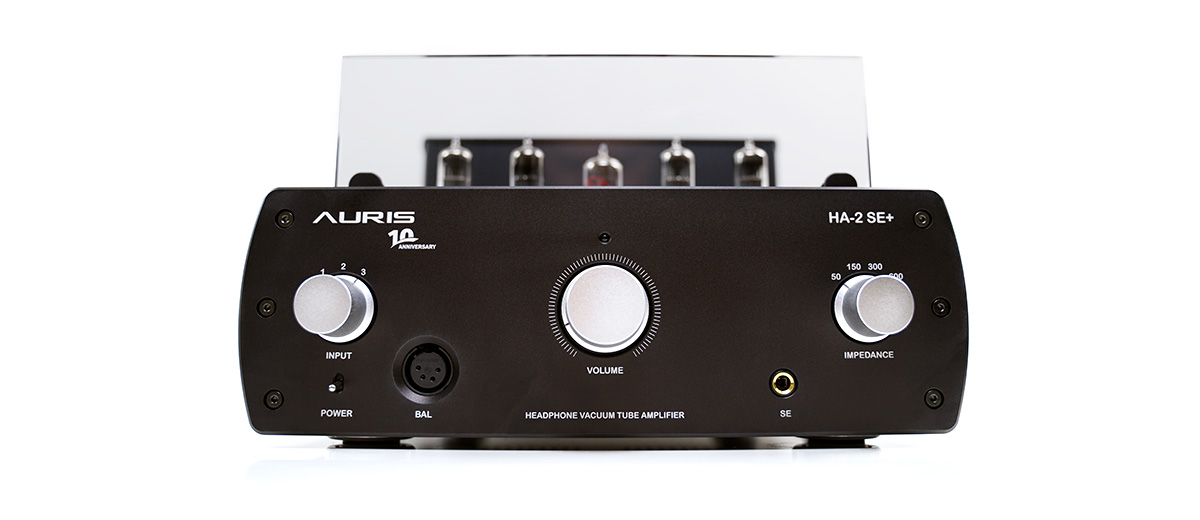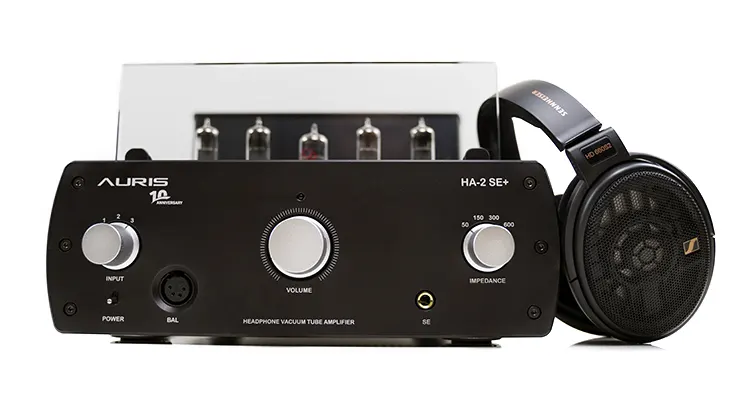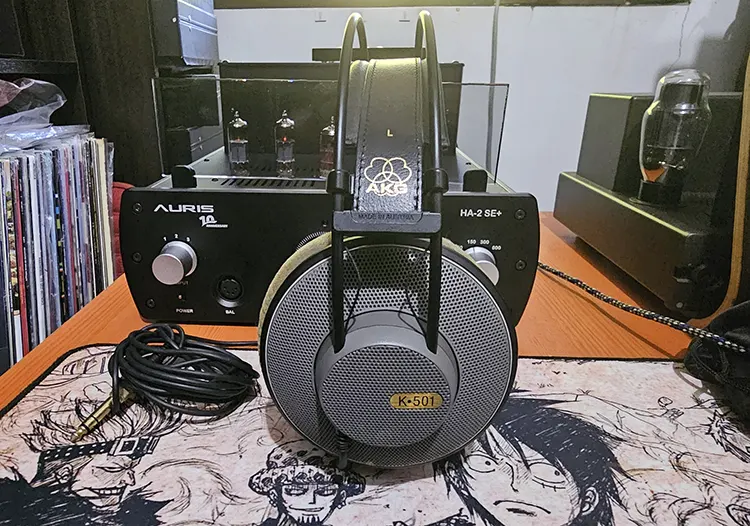Sound Impressions
The following sound impressions were created using the ZMF Headphones Atrium open-back, the Sennheiser HD660S2, and the Focal Utopia 2022. Sources included the Cayin N7 1-BIT DAC balanced pre-out and the Ladder Schumann R-R2 DAC.
Summary
The Auris Audio HA-2SE+ strikes a tone that sits somewhere in between the smooth mid-centric timbre of the original HA-2SE and the dynamic delivery of the more recent HA-2SF.
It conveys a vastly improved holographic soundstage quality compared to the former and a more refined and sweeter overtone through the mids and highs when benchmarked against the drier more neutrally-tuned latter.
It’s a beautiful combination of classic tube warmth and sweetness with the necessary dynamics and clarity modern higher-load headphones such as the 80Ω Euforia 2022 really require to sound optimal.
There are zero issues with regard to headroom for high-impedance headphones such as the Atrium Open, classics such as the AKG K501/500, and even planar headphones such as the LCD-4.
All tested headphones never ran out of juice with just the right amount of sparkling overtone to prevent each pairing from being overly soft or blunted in their delivery.
It differentiates itself from recent OTL competitors such as the EUFORIA evo from Feliks Audio with a performance that I would define as more energetic. Of the two, the HA-2SE+ offers a slightly shorter note decay and a stronger perception of clarity and speed but with a little less sub-bass presence and a stronger mid-bass punch.
The impedance selector option is a difference-maker for me. You can set and forget the matching load value to get a faithful reproduction of your headphones’ tuning or tweak the sound of just about any headphones you want to pair the HA-2SE+ with to your preference.
Be it a stronger vocal presence to increasing the warmth and bloom on the lows with the likes of the LCD-4 or bringing in a more composed tone with dynamic driver options such as the K501 and the HD660S2 it’s a very flexible feature to have.
Coloration
Auris seems to have found a happy medium between the dynamic prowess of the HA-2SF and the more ‘vintage’ coloration of the original.
The HA-2SE+ timbre sounds more refined than the original. In a way cleaner, more defined, and detailed sounding but at the same time, sweeter with an improved harmonic balance. Especially through the mids which sound more complex in their texture benefitting from an improved treble tuning and a much stronger fundamental.
It’s an elegant match with the Utopia 2022 and one which at times I honestly prefer using the 50Ω impedance setting as it tends to strip away a bit of 150Ω aggression from the vocal imaging and lower mids giving you a more studied and dare I say it a comparatively peaceful performance.
If you are coming from the HA-2SF you might lose a bit of that snap and solidity on the lows with more demanding headphones. The HA-2SE+ will not give you the same ‘drive’ and robustness on the lows with planar headphones such as the DCA STEALTH or EXPANSE.
However, the coloration from the HA-2SE+ through the mids and highs is more agreeable to my ear with headphones such as the Sennheiser HA660S2. The HA-2SF’s slightly steelier overtone from the HD660S2 pairing is gone on the HA-2SE+ making it ideal for longer listening sessions.
One thing to note is source influence. The HA-2SE+ will faithfully transmit the subtle differences from various source line-outs.
For example, both the LP P6 Pro, (balanced line-out), and the Ladder Schumann DAC introduced some additional weight and thickness in the performance, whereas the Cayin N7′s 1-BIT DAC pre-out retained a very analog overtone but was comparatively more neutral in bass weight and vocal imaging.
Staging & Dynamics
There is some serious improvement here over the original HA-2SE with a far more holographic and articulate soundstage. The dynamic range benefits massively from a blacker more spacious background giving both instruments and vocals a lot more space to shine for each of our paired headphones.
With particular reference to Utopia 2022, the HA-2SE+ had enough pace and clarity to ensure it’s narrower soundstage and incredible imaging never muddies up the music when it starts picking up in terms of energy and pace.
The original HA-2SE never quite conveyed the same level of separation and space giving everything a comparatively one-dimensional mid-centric character. With Utopia 2022, I felt I was missing a lot of information from both the highs and lows when compared to the performance of the HA-2SE+.
Depth has improved tremendously with the fundamental pitch on many an instrument getting a bit of a lift in both heft and presence. You can amplify this a bit more by tweaking the impedance selector which generally thickens the upper bass and lower mids including vocal presence.
At times an upwards tick on the impedance selector can be too forward-sounding on some headphones such as the Utopia 2022 which ends up being quite in-your-face sounding. Even the HD600S2’s own proper 300Ω setting has more of an intimate-sounding character.
Generally speaking, the lower the HA-2SE+ impedance value the more diminished the presence of both the lows and vocals become. However, if the headphone is already quite intimate or shouty then you can temper this with a lower setting to further refine the staging performance.
Synergy
Power
The Auris Audio HA-2SE+ is rated at a constant 1W throughout its impedance range, meaning you get 1W at 50Ω right up to the 600Ω option officially.
This is a return to the older HA-2SE‘s power rating and lower than the 2W constant output from the HA-2SF, though the switch from the older HA-2SE’s Tung-Sol 12AU7W input tube to the ECC81 does mean a stronger gain rating and ideally, better voltage output.
The synergy with high-impedance loads on the HA-2SE+ is perfect. You will have no issues driving headphones such as the 300Ω-rated ZMF Headphones Atrium and the cheaper Sennheiser HD660S2.
Older classics such as the 120Ω AKG K501 run the juice slightly higher than the ZMF alternatives but still well within the available headroom offered by the HA-2SE+ on the 150Ω impedance setting.
Even relatively efficient planar headphones such as the Audeze MM-500 and the Meze Audio Elite have more than adequate headroom and do not drive the volume too far north on the 50Ω setting.
It is only when you start messing with very demanding headphones such as the Dan Clark Audio Stealth do you start to pick up on some shortfalls of that 1W supply of the HA-2SE+. Compared to the stronger HA-2SF, the bass performance lacks a little solidity and tightness giving it a brighter shallower overtone compared to the older more powerful amp.
Impedance Management
Now, this is where it gets interesting because with impedance management capability ideally, you can match your headphone’s load to the relevant value on the amplifier to get what is considered the truest or best performance.
However, you can set the HA-2SE+ impedance value to whatever you like and test to see if you prefer that sound over the supposedly ‘correct sound’. Especially where the headphone might straddle between the nominal values or is impedance ‘agnostic’ like a planar headphone.
Pairings
For example, the AKG K500 and K501 are both rated at 120Ω and typically seen to be bass-light if underpowered with a mid-centric performance from the K501 and a more neutral response from the K500.
With the 150Ω they both sound composed and ideally, how they should sound with the K501 the warmer and smoother of the two. Neither will spit bass bombs at you, that is not their forte. However, you can tease a little more bloom out of the lows with the HA-2SE+ impedance selector.
If you switch them up to the 300Ω setting you get a slightly fuller lower-mids and a more aggressive midrange imaging experience. It’s not a huge difference but it is noticeable. With the K500 the tone does have a very slight increase in warmth on the lows and like the K501 a slightly beefier more forward mids.
It is a similar trait for the Sennheiser HD660S2 with the 300Ω setting pushing the vocals further forward and introducing some enhanced upper-bass to lower-mid bloom alongside it. Switching to the 150Ω diminishes both those areas giving you a more balanced coloration with a comparatively neutral placement for vocal imaging.
The open-back ZMF Headphones Atrium sounds better for me on the 300Ω setting. Its expansive staging properties are well documented and at 150Ω it sounded flat and weak on the vocal presence compared to the more vibrant HA-2SE+ 300Ω output.
For the Audeze LCD-4 that sits in between the 150 and 300 markers at 200Ω, I much preferred the more forceful sounding 300Ω setting.
If you are a fan of chugging chord-heavy rock the higher impedance value injected some welcome beef and gravitas into those guitar riffs. The 150Ω setting sounded too neutral and well, frankly a bit boring sounding for the LCD-4.







